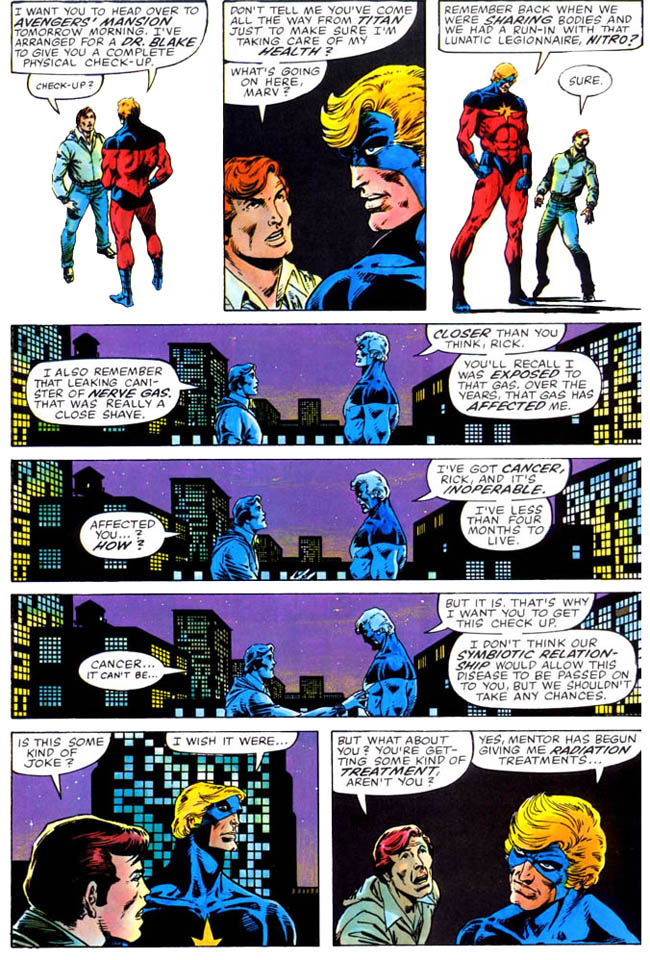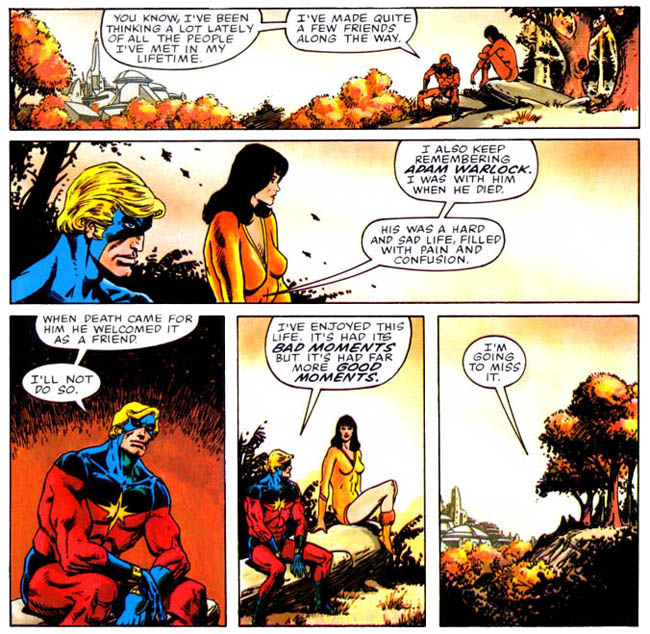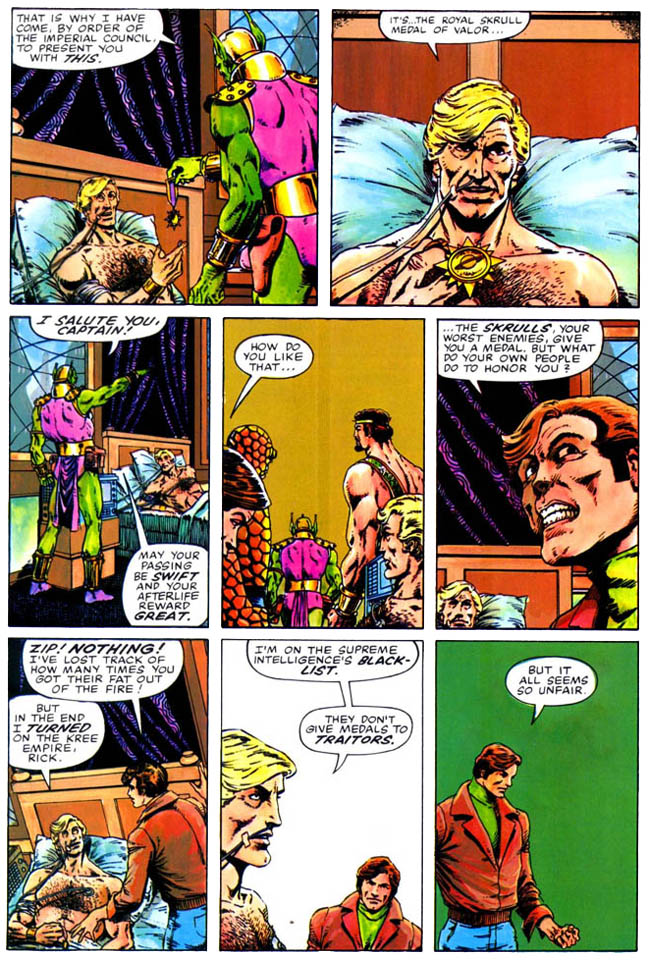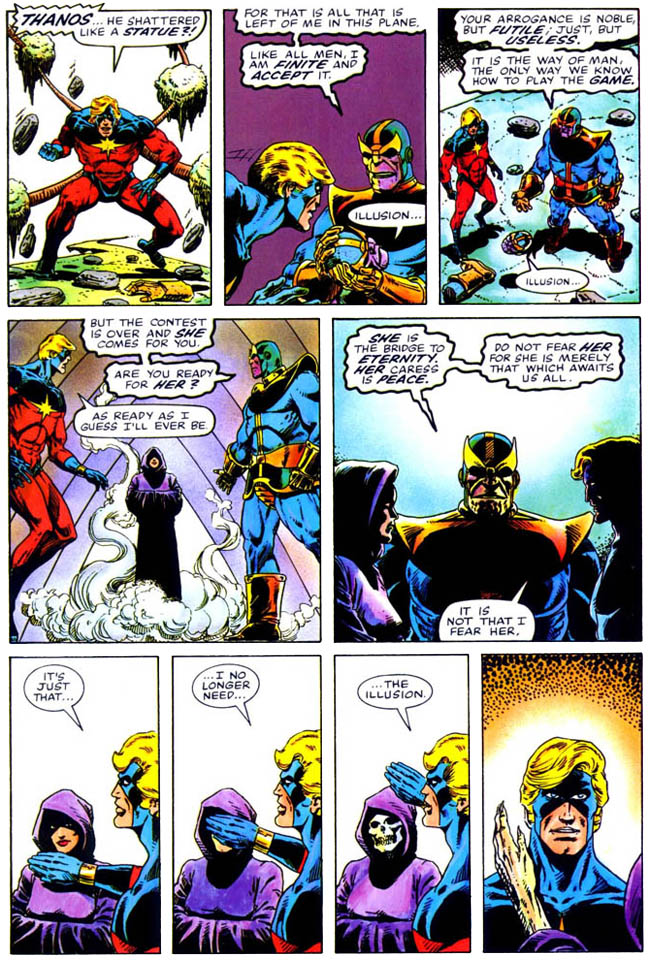Or – “No, It’s Not Spelled Mar-Vell At This Point, Thank You Very Much.”
Before 1982, Captain Marvel existed mostly as a way for Marvel Comics to thumb their nose at the Distinguished Competition. What, you ask, would be the story to finally change that situation? I’ll warn you, it ain’t like your average episode of ‘Happy Days.’ Your Major Spoilers (retro) review awaits!
 MARVEL GRAPHIC NOVEL #1: THE DEATH OF CAPTAIN MARVEL
MARVEL GRAPHIC NOVEL #1: THE DEATH OF CAPTAIN MARVEL
Writer: Jim Starlin
Penciler: Jim Starlin
Inker: Jim Starlin
Colorist: Steve Oliff
Letterer: Jim Novak
Editor: Al Milgrom
Publisher: Marvel Comics
Cover Price: $5.95
Previously, in Marvel Graphic Novel – The Death Of Captain Marvel: The original Captain Marvel (these days known as Shazam, for some reason) was shelved in 1953, the victim of a lawsuit by DC Comics due to a perceived similarity to their signature character, Superman. Fifteen years later, it was believed that Fawcett’s trademark had lapsed, and Marvel successfully launched the green-and-white-suited Kree alien known as Captain Marvel. Never one of the first-tier Marvel characters, Marv nonetheless made enough of a splash to get his book uncancelled and a female counterpart given her own book. After being chosen as the Protector of the Universe by a creature called Eon, Mar-Vell was part of the team that stopped the mad Titan, Thanos. As the 1980s dawned, things were looking up for the man named Marvel…

Okay, technically he isn’t really “named” Marvel, but, whichever… Some younger Spoilerites (and, if our conversations during the podcast are any indicator, Stephen) may not be aware that the use of “Captain Mar-Vell” was not coined until WELL after Marvel’s eventual death, and that the hero had a pretty long run, as comics go. This story opens with Marvel narrating the story of his life as a superhero, a decision that seems somewhat ominous in retrospect. The hero tells of his arrival on Earth, his adoption by the Earth people and his heroic legacies, leading up to his then-recent battle with the mad Thanos of Titan…
 Eros (not yet having taken on the nom de guerre of ‘Starfox’) isn’t entirely sure what to think of the Captain’s sudden interest in recording his legacy, but is distracted by their mission: To find the body of his brother Thanos, turned to stone in a final (for some values of final, anyway) bid for the affections of Lady Death. No, not THAT Lady Death! Thanos unrequited affection was for the living embodiment of the concept of Death in the Marvel Universe, which seemingly led to his demise. Before they can take Titan’s errant son home, however, their group is overrun! The ambush leads to fisticuffs, which the three alien powerhouses easily dispatch, but who would want to attack them anyway?
Eros (not yet having taken on the nom de guerre of ‘Starfox’) isn’t entirely sure what to think of the Captain’s sudden interest in recording his legacy, but is distracted by their mission: To find the body of his brother Thanos, turned to stone in a final (for some values of final, anyway) bid for the affections of Lady Death. No, not THAT Lady Death! Thanos unrequited affection was for the living embodiment of the concept of Death in the Marvel Universe, which seemingly led to his demise. Before they can take Titan’s errant son home, however, their group is overrun! The ambush leads to fisticuffs, which the three alien powerhouses easily dispatch, but who would want to attack them anyway?

Mentor and Eros are shocked as Marv nearly collapses, and offer to run a medical scan to confirm the problem. Captain Marvel, possessed of complete cosmic awareness, informs them that his power works inwardly as well as outwardly, and that he’s pretty certain what is happening to his body already…

Mentor sadly informs the hero that the computers only give him three months at best, a prognosis that Captain Marvel is resigned to. Moreover, he knows what it was that triggered the disease in the first place, the inhalation of nerve gas while battling a villain called Nitro. (These days, Nitro is played a a crazy man, one of the only villains to successfully kill a hero, but here it’s clear that the death was purely accident, and Nitro himself kind of an idiot. I prefer it that way, honestly.) Mar-Vell even knows that the disease is very advanced, and that the power of his Nega-Bands have been holding his cancer in check. Without them, he says, he might have already succumbed. Marvel begins putting his affairs in order, informing his beloved Elysius of his condition, and recording more of his adventures (a clever way of telling people about his history, given that the hero had been out of the spotlight for a little bit before this issue went to print.) He even visited his close friend, Rick Jones, on Earth…

Mar-Vell explains to Rick that the treatments aren’t quite working for his Kree physiology, and (given his exile status) that he doesn’t have much of a chance of overcoming the disease. “I can’t punch, kick or fly away to escape this,” he says, admitting to Rick that he’s starting to accept his own mortality.
 Captain Marvel returns home to Titan and his lover, but contrary to what he told Rick, he hasn’t quite wrapped his mind fully around the concept of his own impending death. Though he has cosmic understanding of the universe, there’s nothing in his powerset that allows him to fully comprehend what happens after he dies…
Captain Marvel returns home to Titan and his lover, but contrary to what he told Rick, he hasn’t quite wrapped his mind fully around the concept of his own impending death. Though he has cosmic understanding of the universe, there’s nothing in his powerset that allows him to fully comprehend what happens after he dies…

Rick, for his part, petitions the Avengers to help cure Mar-Vell, a concept that leaves Iron Man and the Beast stunned, while the rest of the universe slowly comes to be aware of the title of this book…

To his surprise, offers pour in from around the galaxy, as various cultures send their own healers and elixirs, none of which is fully suitable for Marv’s Kree biology. Captain Marvel entreats Eros to take care of Elysius after his death, and continues to record his memoirs, but continues to fight the pain of his prognosis, as well as the classical stages of grief…

I have to say, Jim Starlin does a REALLY good job with the dialogue throughout this book, balancing the cosmic folderal with a naturalistic approach that conveys the hero’s sense of helplessness without turning into a movie of the week. That last panel has me a little bit misty, actually, making a minor hero that I never really cared all that much for into a human being dealing with an unthinkable situation.

The cruel irony (situationally speaking, anyway) is that the very same Nega-Bands that have kept Mar-Vell alive are blocking many of the attempts to cure him, and the heroes of Earth discover that it may just be too late to reverse the effects of Captain Marvel’s cancer. The whole thing may turn out to be moot, however, as Mar-Vell collapses, finally felled by his own cellular decay. The only comfort comes in the knowledge that he is not alone…

In fact, nearly EVERY Marvel hero from the X-Men to Ghost Rider to The Fantastic Four and back, arrive on Titan to pay their respects to one of their own. It’s such a powerful sequence that I forget to ask who is watching out for Earth, instead being drawn into the story to the degree that it just seems appropriate for the community of the supernature to stand at Mar-Vell’s bedside. But even the heroes have difficulty processing a situation like this…

I have to once again express my appreciation of the job that Starlin does with this issue, as Spider-Man and the Beast (Marvel’s two most light-hearted, wise-cracking heroes) have a discussion about one of their own dying, a moment that could have turned into bathos in the wrong hands. Of course, the superheroes aren’t the only ones who have come to Titan to visit their friend in his final hours…

This is the point where I fell apart upon reading this book for the first time (a Zach-lifetime ago, now). as Rick’s appearance without a deus ex machina miracle cure really feels like the last nail in Captain Marvel’s coffin. Even with the title of the book being what it is, readers circa 1982 weren’t fully expecting for it to be exactly what it said on the tin, but this tearful reunion is what clinched it for me. Of course, Starlin then followed it with another strange-yet-heartwarming moment, as an official representative of the Skrull empire (his lifelong enemies, you will recall) arrives at his bedside…

“You have always been our greatest enemy.” That gives me goosebumps, to this day. As for the Kree, Mar-Vell has no use for his people, remarking that he has his friends, he has his true love, and that his people can shove their own regards up their collective butts, though I may be paraphrasing. Captain Marvel falls into a coma soon after, and his friends and colleagues gather together, unaware that his mind is fully active. Captain Marvel finds himself visited by a rejuvenated Thanos, who reverts him to his full superhero form and attacks, promising one final battle for the dying warrior. Captain Marvel struggles in a strange mindscape (a Starlin specialty) battling the ghosts of his greatest enemies, declaring that as long as he has life, there is still hope!

Acceptance comes at last, as Mar-Vell finally gives up the fight, accepting the kiss of Mistress Death as his heart (a representation of which hangs in the sky of his strange pseudo-reality) slows and finally, stops. “There is more,” promises Thanos. “She will show us that this is not the end…”

…
Even now, it’s a little bit hard to believe how well this story reads, and how much skill went into the creation of one of the only superhero tales where our hero was going to lose his fight. Most wonderful to me is the fact that the back cover (which I looked at first) actually serves as the final panel of the story, as friends and heroes gather to lay the remains of Captain Marvel to rest…

At the time I first read this book, I had been to only one funeral, and found the whole thing to be maddening and strange, with everyone acting completely out of character and no real way for me to comprehend what had really just happened. Rereading it now, I am still impressed with the book as a comic book story, but the events of the ensuing 30 years have instilled in me a greater appreciation of the way Starlin handles the very adult concept of death and mortality. Captain Marvel’s struggle to accept that he is going to die is touching and frightening all at once, while the fact that the only fighty-fighty in the book takes place in Captain Marvel’s mind makes it even more wonderful. Spider-Man laments that superheroes die due to explosions or accidents, but Mar-Vell’s death comes in a perfectly human way, and Starlin captures that amazingly well. Marvel Graphic Novel #1: The Death of Captain Marvel still holds up, and its main story point hasn’t been reversed (barring a Skrull and a few semi-dream sequences), something that I wish we could say about Barry Allen, Kara Zor-El and Steve Rogers, and this one isn’t going to be earning anything less than 5 out of 5 stars overall. This book created and codified the rules of the proper Graphic Novel, at least for the Big Two Universes, and remains the strongest of Marvel’s graphic novels, and one of the strongest stories in the entirety of Bronze Age Marvel.
DID YOU READ THIS ISSUE? RATE IT!
Reader Rating
[ratings]




8 Comments
Thanks for the great review of a powerful story (perhaps Starlin’s finest moment). The sheer humanity of the tale still gets me.
Sadly, it also set the bar VERY high for Marvel’s graphic novels, a challenge that was seldom met.
Great review!
Yes, this was the first of the Marvel graphic novels. RHS was correct above when he mentioned that few, if any, of the others reached the level of this book, StarStruck being the only one I can think of right off hand. Since I last read this graphic novel, I’ve lost my own mother to cancer. This book and “I Kill Giants” can choke me up at a moment’s notice. This story remains one of the strongest graphic novels ever written, and managed not to succumb to the late 70s early 80s “overly explain everything on panel” syndrome, which renders the Teen Titans graphic novels so painful to read today.
“Look! We are falling! I shall extract my Nutroneium Pew 38 rocket staff which shall extend to great lengths and then collapse in on itself thus breaking our fall and saving our live!*” *Editors note: See page 43 of Stuporman Summer Fun Family Freakout for explanation of the words saving, our and lives – Editor in charge of Inflating Dialog. “So you’re telling me your rocket staff suffers from the same performance issues as you have, Former Robin Boy?”
I wonder, just what has Jim Starlin been up to since the 80s? No longer having access to a comic book store, I’ve lost track of anything he may have done since the Death of Captain Marvel.
He did the Infinity trilogy for Marvel, and took a run at Captain Comet pre-New 52. I think he’s also been working on creator-owned cosmic things that always seemed vaguely Warlock-like.
Damnit I need to get this one for my collection. A masterpiece of graphic literature.
Thank you for this great review.
I’ve been waiting for a long time to see this book reviewed and your efforts are greatly appreciated.
I bought this when it first came out, and it made me cry. I was 8 then. A few months ago I lost my dad to lung cancer, and damn my experience to date makes this comic resonate even more. My appreciation for it grows, even as most of the other comics of the day comes across as campy today. This is still one of my favorite comics.
Yep,..that’s the way I remember it.